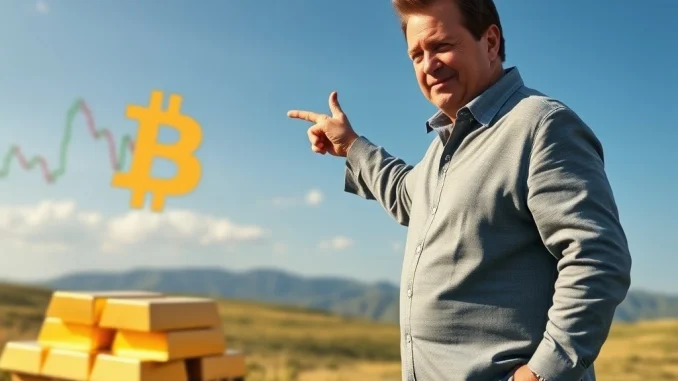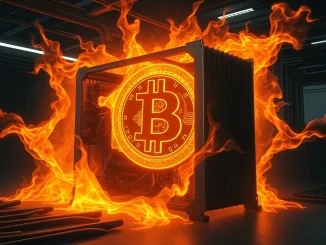
In the ever-evolving world of digital finance, a compelling debate is unfolding at the intersection of traditional wisdom and modern investment trends. As Bitcoin continues to capture headlines and institutional interest, a stark warning has emerged from an unlikely yet highly respected voice: Robert Kiyosaki, the best-selling author of Rich Dad Poor Dad. He’s challenging the very foundation of how many investors approach wealth, particularly as Crypto ETFs experience unprecedented surges. But why is a financial guru cautioning against what appears to be a lucrative opportunity? Let’s dive deep into Kiyosaki’s crucial insights and understand the profound implications for your portfolio.
Robert Kiyosaki’s Stark Warning: Beyond Paper Promises
On July 25, 2025, renowned financial commentator Robert Kiyosaki took to his social media platform to issue a critical caution to investors. His message was clear: relying heavily on paper assets, even those tied to precious commodities or cryptocurrencies, could leave investors vulnerable during periods of financial uncertainty. Kiyosaki, known for his unconventional yet pragmatic financial advice, emphasized the irreplaceable value of tangible holdings.
He drew a powerful analogy, stating, “A photograph is not a weapon,” to highlight the fundamental difference between a representation of an asset and the asset itself. This statement underscores his belief that during economic downturns, the true value and utility lie in direct ownership of physical assets like gold, silver, and yes, even Bitcoin, which he views as digital gold.
The Unstoppable Rise of Crypto ETFs: A Double-Edged Sword?
Despite Kiyosaki’s warnings, the appeal of exchange-traded funds (ETFs) has surged throughout 2025. This rise is largely driven by volatile stock markets and persistently low bond yields, pushing investors towards alternatives. Both gold and Bitcoin-backed ETFs have seen significant appreciation, each climbing by approximately 28% this year. By April 2025, gold-backed ETFs alone had attracted over $170 billion in assets, signaling a strong investor preference for “paper gold” over physical bullion.
The institutional demand for Crypto ETFs has been particularly robust. The iShares Ethereum Trust, managed by financial giant BlackRock, is a prime example. Its assets remarkably ballooned from $5 billion to $10 billion within a mere ten days, cementing its status as the third-fastest-growing ETF in U.S. history. Over the past month, Ethereum ETFs recorded an impressive $4.7 billion in inflows, with total net flows reaching $8.88 billion. These figures undeniably highlight a growing institutional appetite for digital assets, offering accessibility and liquidity.
Why Prioritize Physical Assets in an Uncertain Market?
Kiyosaki, however, maintains that ETFs represent mere claims on assets rather than the assets themselves. This distinction, he argues, can create significant gaps in market value when financial systems come under stress. He cautions that investors who lack direct ownership of physical commodities could face severe vulnerabilities, particularly when market liquidity dries up.
His core argument revolves around resilience. “Physical gold and silver offer resilience during financial downturns,” he reiterates, contrasting this with ETFs, which he believes may lose their perceived value when crises emerge. For Kiyosaki, true physical assets—including Bitcoin in his view—provide a foundational security that paper representations cannot match. They offer direct control and eliminate counterparty risk, which becomes paramount when trust in financial institutions falters.
Actionable Insights for Wealth Preservation
The ongoing debate over physical versus paper assets has gained urgency amid broader market shifts and economic uncertainties. Kiyosaki’s insights align with broader concerns about the reliability of derivative instruments in volatile conditions. While ETFs offer convenience and liquidity, they inherently lack the intrinsic security of direct, physical holdings. His analogy of an image versus the actual asset serves as a powerful reminder for investors to critically reevaluate their portfolios.
For investors seeking robust wealth preservation, Kiyosaki’s call for tangible assets—gold, silver, and Bitcoin—reflects a strategic pivot. His analysis, rooted in practical experience and keen market observations, challenges conventional investment strategies that often prioritize convenience over direct ownership. As financial markets continue to evolve, understanding the tension between physical assets and their paper representations remains a pivotal consideration for those seeking long-term stability.
Physical Assets vs. Paper Assets (ETFs)
| Feature | Physical Assets (Gold, Silver, Bitcoin) | Paper Assets (ETFs) |
|---|---|---|
| Ownership | Direct, tangible possession | Claim on an underlying asset, indirect ownership |
| Security | Intrinsic value, resilient in crises, no counterparty risk | Dependent on issuer solvency, potential for market gaps |
| Liquidity | Can be less liquid, but always has intrinsic value | High liquidity in normal markets, can dry up in stress |
| Control | Full control over your asset | Relies on fund manager/custodian |
| Kiyosaki’s View | Preferred for true wealth preservation | Vulnerable, not equivalent to the real asset |
In conclusion, while the allure of surging Crypto ETFs and other paper assets is undeniable, Robert Kiyosaki offers a timely reminder of the fundamental importance of physical ownership. His message urges investors to look beyond convenience and consider the intrinsic security and resilience that only tangible assets can provide, especially when navigating unpredictable financial waters. As you shape your investment strategy, reflecting on Kiyosaki’s wisdom might just be the most valuable asset you acquire.
Frequently Asked Questions (FAQs)
What is Robert Kiyosaki’s primary warning regarding investments?
Robert Kiyosaki warns investors against over-reliance on paper assets like ETFs, emphasizing that they are claims on assets rather than direct ownership. He cautions that these could become vulnerable during financial crises when liquidity dries up.
Why does Kiyosaki advocate for physical assets like Bitcoin and gold over ETFs?
Kiyosaki believes physical assets offer intrinsic security and resilience. Unlike ETFs, which are paper representations, physical gold, silver, and Bitcoin provide direct ownership, eliminating counterparty risk and retaining value during economic downturns.
What are the perceived risks of crypto ETFs, despite their recent surge?
According to Kiyosaki, the main risk is that crypto ETFs, despite their high liquidity in normal times, are still paper claims. In periods of market stress, the gap between the ETF’s value and the underlying asset’s value can widen, and liquidity might disappear, leaving investors with a less valuable claim.
How has the iShares Ethereum Trust performed, and what does it signify?
The iShares Ethereum Trust saw a rapid increase in assets, growing from $5 billion to $10 billion in just ten days. This signifies a strong and growing institutional appetite for digital assets, highlighting their increasing acceptance within traditional finance.
What actionable advice does Kiyosaki offer investors for wealth preservation?
Kiyosaki advises investors to prioritize direct ownership of tangible assets like physical gold, silver, and Bitcoin. His counsel suggests a strategic pivot towards these assets for long-term wealth preservation, encouraging a reevaluation of portfolios to balance convenience with intrinsic security.



